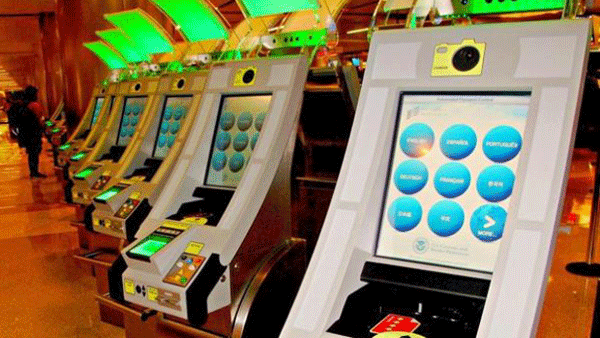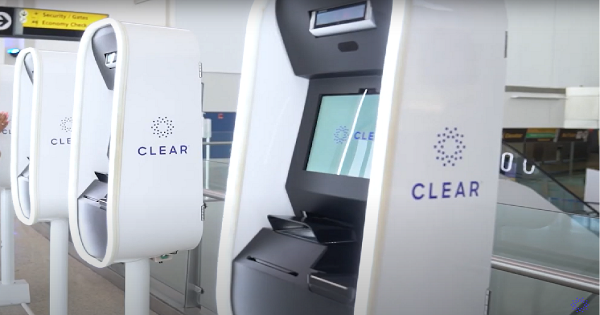Forty (40) new Automated Passport Control (APC) kiosks unveiled at Los Angeles International Airport (LAX) expedite the entry process for international arriving passengers at the airport’s Tom Bradley International Terminal.

U.S. and Canadian citizens arriving from abroad, as well as passengers from the 38 Visa Waiver Countries who are also registered with the U.S. Customs and Border Protection’s (CBP) Electronic System for Travel Authorization (ESTA) program, are eligible to use the new machines.
APC kiosks allow international travelers, including family groups, to submit their customs declaration form and biographic information electronically, thereby reducing the time they spend with a CBP officer.
Passengers can select from 13 languages to use. Easy-to-follow instructions guide the user through the process, which includes scanning your passport, taking a photograph using the kiosk, answering questions, and fingerprinting for non-U.S. citizens.
Passengers will then receive a receipt confirming their information and proceed to a CBP officer to complete their entry into the United States. Individuals can complete the process within 90 seconds and a family of three within four minutes.
“These kiosks will allow passengers to avoid long lines and reduce wait times at Customs, so they can be out the door faster and on their way to exploring the greatest city in the world,” said Los Angeles Mayor Eric Garcetti. “This important improvement to the passenger experience is all part of our work to overhaul nearly every terminal and bring rail to LAX, because Los Angeles deserves a world-class airport.”
“After a long flight, the last thing passengers want to do is stand in line to process through federal inspection to enter the U.S.,” said Los Angeles World Airports (LAWA) Executive Director Gina Marie Lindsey. “With faster processing times, shorter lines, and increased convenience these APC kiosks bring to LAX, we expect the passenger experience of the millions of international passengers who travel through LAX each year to improve substantially. We thank the U.S. Customs and Border Protection and the airlines operating in the Tom Bradley International Terminal for their invaluable support of this program.”
APC is a free service, does not require pre-registration or membership, and maintains the highest levels of protection when it comes to the handling of personal data or information. Travelers opting to use the kiosks will no longer have to fill out a paper customs declaration form.
Passengers will still be inspected by a CBP officer to verify the purpose and intent of their travel. However, the self-service kiosk removes the administrative responsibility for a CBP officer to scan a traveler’s document, allowing for shorter processing times. Passengers then proceed to baggage claim, customs declaration, and exit.
Passengers have already experienced a reduction in wait times for primary inspection at the Tom Bradley International Terminal during the recent start-up period. This is especially true for returning U.S. citizens, who are experiencing an average 39 percent reduction in wait times. For example, airport officials expect a flight with 300 passengers to normally process in 45 minutes with multiple booths open and without APC kiosks. With APC kiosks, returning U.S. citizens are waiting an average 17.5 minutes less.
Eligible foreign passport holders are experiencing an average 18 percent reduction in wait times. Airport officials expect a flight with 300 passengers to normally process in 60 minutes with multiple booths open and without APC kiosks. With the APC kiosks, eligible foreign passport holders are waiting an average 11 minutes less for primary inspection.
The $2-million project cost was funded by LAWA, the Los Angeles City department that owns and operates LAX and two other Southern California airports. Each APC kiosk costs $36,000. TBITEC (Tom Bradley International Terminal Equipment Company), the consortium of the 39 airlines operating in TBIT, will fund the estimated $1.6-million annual cost for staff to direct and assist travelers with questions on using the new machines. All the kiosks are under the jurisdiction of and connected to CBP’s operations at LAX.
“U.S. Customs and Border Protection places a significant value on our public-private partnerships and we continue to collaborate on innovations to improve the international arrivals process. The Automated Passport Control kiosks are a prime example of CBP’s private sector partners taking a leadership role in purchasing and deploying a solution that is mutually beneficial for CBP, airline carriers, airport authorities, and international air travelers,” said Todd Hoffman, CBP port director for Los Angeles International Airport.
According to Hoffman, APC is part of a comprehensive strategy to optimize CBP’s current resources. CBP continues to explore automation, innovation, sustainable initiatives and trusted traveler programs to streamline the traveler inspection process.
Almost a million times each day, CBP officers welcome international travelers to the U.S. In screening both foreign visitors and returning U.S. citizens, CBP uses a variety of techniques to ensure global tourism remains safe and strong.
LAX officials expect nearly 70 million total passengers will use LAX this year, of which approximately 19 million will be international travelers. The Tom Bradley International Terminal serves almost half of LAX’s international market, of which over five million are expected to be inbound passengers who might process through the upgraded federal inspection screening.
Airport officials are planning to install APC kiosks in Terminal 2, LAX’s secondary international terminal, during its recently started $320-million terminal renovation, which is scheduled to finish in 2016. Similar technology is currently in use in Terminal 5, installed by Delta Air Lines as part of its on-going $250-million renovation program.






